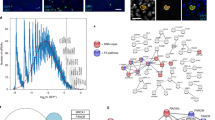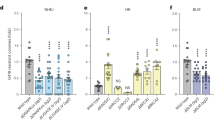Abstract
Long interspersed elements (LINE-1s) are abundant retrotransposons in mammalian genomes that probably retrotranspose by target site-primed reverse transcription (TPRT)1,2. During TPRT, the LINE-1 endonuclease cleaves genomic DNA3, freeing a 3′ hydroxyl that serves as a primer for reverse transcription of LINE-1 RNA by LINE-1 reverse transcriptase. The nascent LINE-1 cDNA joins to genomic DNA, generating LINE-1 structural hallmarks such as frequent 5′ truncations, a 3′ poly(A)+ tail and variable-length target site duplications (TSDs)2. Here we describe a pathway for LINE-1 retrotransposition in Chinese hamster ovary (CHO) cells that acts independently of endonuclease but is dependent upon reverse transcriptase. We show that endonuclease-independent LINE-1 retrotransposition occurs at near-wildtype levels in two mutant cell lines that are deficient in nonhomologous end-joining (NHEJ). Analysis of the pre- and post-integration sites revealed that endonuclease-independent retrotransposition results in unusual structures because the LINE-1s integrate at atypical target sequences, are truncated predominantly at their 3′ ends and lack TSDs. Moreover, two of nine endonuclease-independent retrotranspositions contained cDNA fragments at their 3′ ends that are probably derived from the reverse transcription of endogenous mRNA. Thus, our results suggest that LINE-1s can integrate into DNA lesions, resulting in retrotransposon-mediated DNA repair in mammalian cells.
This is a preview of subscription content, access via your institution
Access options
Subscribe to this journal
Receive 12 print issues and online access
$209.00 per year
only $17.42 per issue
Buy this article
- Purchase on Springer Link
- Instant access to full article PDF
Prices may be subject to local taxes which are calculated during checkout




Similar content being viewed by others
References
Luan, D.D., Korman, M.H., Jakubczak, J.L. & Eickbush, T.H. Reverse transcription of R2Bm RNA is primed by a nick at the chromosomal target site: a mechanism for non-LTR retrotransposition. Cell 72, 595–605 (1993).
Moran, J.V. & Gilbert, N. Mammalian LINE-1 retrotransposons and related elements. in Mobile DNA II (eds Craig, N., Craggie, R., Gellert, M. & Lambowitz, A.) 836–869 (ASM, Washington DC, 2002).
Feng, Q., Moran, J.V., Kazazian Jr, H.H. & Boeke, J.D. Human L1 retrotransposon encodes a conserved endonuclease required for retrotransposition. Cell 87, 905–916 (1996).
Moran, J.V. et al. High frequency retrotransposition in cultured mammalian cells. Cell 87, 917–927 (1996).
Wei, W., Morrish, T.A., Alisch, R.S. & Moran, J.V. A transient assay reveals that cultured human cells can accommodate multiple LINE-1 retrotransposition events. Anal. Biochem. 284, 435–438 (2000).
Sassaman, D.M. et al. Many human L1 elements are capable of retrotransposition. Nature Genet. 16, 37–43 (1997).
Wei, W. et al. Human L1 retrotransposition: cis preference versus trans complementation. Mol. Cell. Biol. 21, 1429–1439 (2001).
Voliva, C.F., Martin, S.L., Hutchison, C.A.D. & Edgell, M.H. Dispersal process associated with the L1 family of interspersed repetitive DNA sequences. J. Mol. Biol. 178, 795–813 (1984).
Teng, S.C., Kim, B. & Gabriel, A. Retrotransposon reverse-transcriptase-mediated repair of chromosomal breaks. Nature 383, 641–644 (1996).
Li, Z. et al. The XRCC4 gene encodes a novel protein involved in DNA double-strand break repair and V(D)J recombination. Cell 83, 1079–1089 (1995).
Blunt, T. et al. Defective DNA-dependent protein kinase activity is linked to V(D)J recombination and DNA repair defects associated with the murine scid mutation. Cell 80, 813–823 (1995).
Giaccia, A.J. et al. Human chromosome 5 complements the DNA double-strand break-repair deficiency and γ-ray sensitivity of the XR-1 hamster variant. Am. J. Hum. Genet. 47, 459–469 (1990).
Kojima, T., Nakajima, K. & Mikoshiba, K. The disabled 1 gene is disrupted by a replacement with L1 fragment in yotari mice. Mol. Brain Res. 75, 121–127 (2000).
Mager, D., Henthorn, P. & Smithies, O. A Chinese G γ + (A γ Δ β) zero thalassemia deletion: comparison to other deletions in the human β-globin gene cluster and sequence analysis of the breakpoints. Nucleic Acids Res. 13, 6559–6575 (1985).
Priestley, A. et al. Molecular and biochemical characterisation of DNA-dependent protein kinase-defective rodent mutant irs-20. Nucleic Acids Res. 26, 1965–1973 (1998).
Luan, D.D. & Eickbush, T.H. RNA template requirements for target DNA-primed reverse transcription by the R2 retrotransposable element. Mol. Cell. Biol. 15, 3882–3891 (1995).
Chambeyron, S., Bucheton, A. & Busseau, I. Tandem UAA repeats at the 3′ end of the transcript are essential for precise initiation of reverse transcription of the I factor in Drosophila melanogaster. J. Biol. Chem. online publication 6 March 2002 (DOI: 10.1074/bc.M200996200).
Ovchinnikov, I., Troxel, A.B. & Swergold, G.D. Genomic characterization of recent human LINE-1 insertions: evidence supporting random insertion. Genome Res. 11, 2050–2058 (2001).
Levin, H.L. It's prime time for reverse transcriptase. Cell 88, 5–8 (1997).
Pardue, M.L., Danilevskaya, O.N., Traverse, K.L. & Lowenhaupt, K. Evolutionary links between telomeres and transposable elements. Genetica 100, 73–84 (1997).
Higashiyama, T., Noutoshi, Y., Fujie, M. & Yamada, T. Zepp, a LINE-like retrotransposon accumulated in the Chlorella telomeric region. EMBO J. 16, 3715–3723 (1997).
Stamato, T.D., Weinstein, R., Giaccia, A. & Mackenzie, L. Isolation of cell cycle-dependent γ ray-sensitive Chinese hamster ovary cell. Somat. Cell Genet. 9, 165–173 (1983).
Fuller, L.F. & Painter, R.B. A Chinese hamster ovary cell line hypersensitive to ionizing radiation and deficient in repair replication. Mutat. Res. 193, 109–121 (1988).
Stoneking, M. et al. Alu insertion polymorphisms and human evolution: evidence for a larger population size in Africa. Genome Res. 7, 1061–1071 (1997).
Li, J. et al. Leukaemia disease genes: large-scale cloning and pathway predictions. Nature Genet. 23, 348–353 (1999).
Carroll, M.L. et al. Large-scale analysis of the Alu Ya5 and Yb8 subfamilies and their contribution to human genomic diversity. J. Mol. Biol. 311, 17–40 (2001).
Dombroski, B.A., Mathias, S.L., Nanthakumar, E., Scott, A.F. & Kazazian Jr, H.H. Isolation of an active human transposable element. Science 254, 1805–1808 (1991).
Narita, N. et al. Insertion of a 5′ truncated L1 element into the 3′ end of exon 44 of the dystrophin gene resulted in skipping of the exon during splicing in a case of Duchenne muscular dystrophy. J. Clin. Invest. 91, 1862–1867 (1993).
Kondo-Iida, E. et al. Novel mutations and genotype-phenotype relationships in 107 families with Fukuyama-type congenital muscular dystrophy (FCMD). Hum. Mol. Genet. 8, 2303–2309 (1999).
Cost, G.J. & Boeke, J.D. Targeting of human retrotransposon integration is directed by the specificity of the L1 endonuclease for regions of unusual DNA structure. Biochemistry 37, 18081–18093 (1998).
Acknowledgements
We thank members of the Univ. of Michigan Flow Core for help with flow cytometry, and R. Lyons at the Univ. of Michigan DNA Sequencing Core for help with sequencing. We thank T. Wilson, T. Glover, J. Goodier and current members of the Moran Lab for helpful discussions during the course of this work. J.V.M. is supported in part by grants from the W.M. Keck Foundation and the National Institutes of Health (NIH). M.A.B. is supported in part by the NIH and the Louisiana Board of Regents Millennium Trust Health Excellence Fund. G.E.T is a scholar of the Leukemia and Lymphoma Society and receives lab support from the NIH and the Aids for Cancer Research. T.D.S. is supported by grants from the NIH. T.A.M. was supported in part by an NIH training grant. Sequencing costs were defrayed partly by a grant to the Univ. of Michigan Cancer Center.
Author information
Authors and Affiliations
Corresponding author
Ethics declarations
Competing interests
The authors declare no competing financial interests.
Rights and permissions
About this article
Cite this article
Morrish, T., Gilbert, N., Myers, J. et al. DNA repair mediated by endonuclease-independent LINE-1 retrotransposition. Nat Genet 31, 159–165 (2002). https://doi.org/10.1038/ng898
Received:
Accepted:
Published:
Issue Date:
DOI: https://doi.org/10.1038/ng898
This article is cited by
-
Structures, functions and adaptations of the human LINE-1 ORF2 protein
Nature (2024)
-
The interferon stimulated gene-encoded protein HELZ2 inhibits human LINE-1 retrotransposition and LINE-1 RNA-mediated type I interferon induction
Nature Communications (2023)
-
Fanconi anemia DNA crosslink repair factors protect against LINE-1 retrotransposition during mouse development
Nature Structural & Molecular Biology (2023)
-
Zidovudine inhibits telomere elongation, increases the transposable element LINE-1 copy number and compromises mouse embryo development
Molecular Biology Reports (2021)
-
Machine learning reveals bilateral distribution of somatic L1 insertions in human neurons and glia
Nature Neuroscience (2021)



